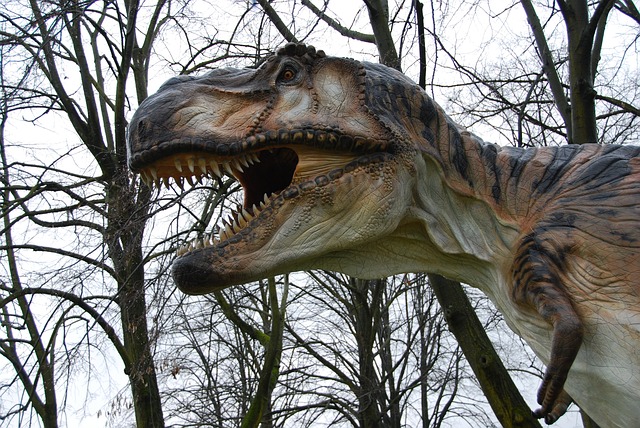Inside the T. rex tooth
Interview with
Carnivorous dinosaurs belonged to a group know as theropods. Their teeth were their main weapons and were used to tear through the flesh of prey, or rivals, as quickly and efficiently as possible. Until now, it had been assumed that these teeth were relatively simple in nature and had evolved just to be very big and very sharp. However, new research suggests that there's a lot more going on beneath the surface than you might think. James Farr spoke to Kirstin Brink, from the University of Toronto, to travel back in time and work out why T. rex was so notoriously deadly...
their main weapons and were used to tear through the flesh of prey, or rivals, as quickly and efficiently as possible. Until now, it had been assumed that these teeth were relatively simple in nature and had evolved just to be very big and very sharp. However, new research suggests that there's a lot more going on beneath the surface than you might think. James Farr spoke to Kirstin Brink, from the University of Toronto, to travel back in time and work out why T. rex was so notoriously deadly...
Kirstin - One characteristic of theropod teeth is that they have serrations. So, if you can picture a steak knife, they have these tiny bumps on the front and back of the teeth and that helps to pierce through the flesh of the animal that they were eating.
James - Well, that's a wonderful image. As if Jurassic World wasn't scary enough already, now, I'm imagining all the dinosaurs with rows of glinting steak knives in their mouths. Metal mouth dinosaurs aside, how do you go about finding what dinosaur's teeth look like on the inside?
Kirstin - What I did was to cut open the teeth of 8 different types of theropod dinosaur. So this includes one of the most well-known theropods - Tyrannosaurus rex. And then after they were cut, some of them, I would grind down so that I could look at them under a microscope and look at the structure of the tissues. Some of them, I didn't grind them down, but I looked at the cut surfaces with a scanning electron microscope which is a different type of powerful microscope. And some of the teeth, after they were cut, we analysed them in a synchrotron which actually analyses the chemical composition of a tissue. When you look inside the teeth of the theropod dinosaurs, they have these really kind of complex unique structures that haven't been seen in the teeth of any other animal.
James - It would seem that there's a lot more to these teeth than meets the eye then. Not only are they serrated, but it turns out that their internal tissues are arranged in a very unusual way around the bases of these serrations. These have big benefits for your average T. rex on a day to day basis.
Kirstin - So, the structure actually helps to increase the size of the serration within the tooth and that in turn strengthens each serration and prevents them from wearing away while the dinosaur is eating.
James - That's sounds very handy to me. They must have saved an absolute fortune on dentist's bills. The carnivorous dinosaurs are well-known for their vicious teeth and yet previously, these teeth had been thought to be very straightforward.
Kirstin - Typically, animals that eat meat don't have as complex teeth as animals that eat mainly plants. Plants are very hard to chew and so those teeth wear away much more quickly, and so the teeth need to be much more complex in order to resist that wear. So, it's really surprising that a theropod would have complex teeth as well, considering that they're eating much softer foods.
James - Previous theories had suggested that the serrations in the theropods teeth had been caused by the strains of eating as each dinosaur aged. However, since their food is generally quite soft, this seemed rather unlikely.
Kirstin - So, I looked at teeth that were fully mature and I also looked at teeth that were still developing within the jaw of the dinosaur. So, they had not been subjected to any stresses through feeding. And these unique structures are present in the immature and mature teeth.
James - The main question that remains is whether the 8 theropods studied are the only animals that have these intriguing dental structures.
Kirstin - I've only examined 8 theropods in this study and there are many, many more known. So, we really need to look at, if this unique structure is present in any other theropod dinosaurs. It's also kind of interesting that the first birds also had teeth that had serrations on them. So, that might be interesting too to see if the first birds had teeth that were very similar to other large theropod dinosaurs.
Chris - Kirstin Brink from the University of Toronto, her paper came out this week in Scientific Reports.










Comments
Add a comment